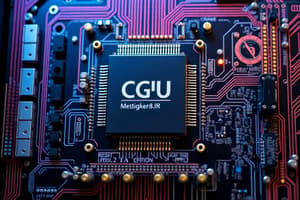Podcast
Questions and Answers
What is the function of the Program Count Register (PC)?
What is the function of the Program Count Register (PC)?
- Determines memory capacity
- Tests contents for conditions
- Stores instruction fetched from memory (correct)
- Stores values from other locations
What is the role of the Instruction Register (IR)?
What is the role of the Instruction Register (IR)?
- Stores instruction fetched from memory (correct)
- Stores values from other locations
- Shifts or rotates data
- Determines memory capacity
What does the Memory Data Register (MDR) do?
What does the Memory Data Register (MDR) do?
- Stores instruction fetched from memory
- Shifts or rotates data
- Tests contents for conditions
- Stores values from other locations (registers and memory) (correct)
What determines the memory capacity?
What determines the memory capacity?
Which type of RAM requires refreshing thousands of times each second?
Which type of RAM requires refreshing thousands of times each second?
What is the function of the ALU in a CPU?
What is the function of the ALU in a CPU?
What is the main function of the control unit in a CPU?
What is the main function of the control unit in a CPU?
What is the purpose of registers in a CPU?
What is the purpose of registers in a CPU?
Which component of the CPU is responsible for supervising fetching instructions and data from memory?
Which component of the CPU is responsible for supervising fetching instructions and data from memory?
What are General Purpose Registers in a CPU mainly used for?
What are General Purpose Registers in a CPU mainly used for?
Flashcards are hidden until you start studying
Study Notes
CPU Registers and Components
- The Program Count Register (PC) holds the memory address of the next instruction to be fetched.
- The Instruction Register (IR) stores the current instruction being executed.
- The Memory Data Register (MDR) temporarily holds data being transferred between the CPU and memory.
Memory Capacity
- The memory capacity is determined by the number of address lines and the number of bits in each word.
RAM
- Dynamic RAM (DRAM) requires refreshing thousands of times each second to maintain the stored data.
ALU
- The Arithmetic Logic Unit (ALU) performs arithmetic and logical operations, such as addition, subtraction, AND, and OR.
Control Unit
- The control unit retrieves and decodes instructions, generates control signals, and manages data flow between components.
Registers
- Registers in a CPU are small amounts of on-chip memory that store data temporarily while it is being processed.
- The purpose of registers is to provide quick access to data and reduce the time it takes to access memory.
Control Unit Function
- The control unit is responsible for supervising the fetch-decode-execute cycle, which includes fetching instructions and data from memory.
General Purpose Registers
- General Purpose Registers in a CPU are used to store both data and addresses, and are used for various operations, such as arithmetic and logical instructions.
Studying That Suits You
Use AI to generate personalized quizzes and flashcards to suit your learning preferences.




